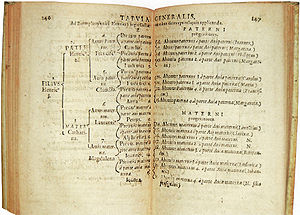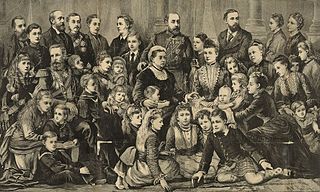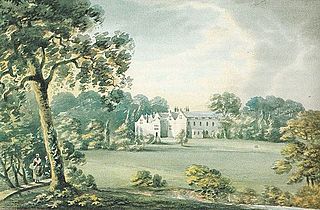
Several genealogical numbering systems have been widely adopted for presenting family trees and pedigree charts in text format.

Several genealogical numbering systems have been widely adopted for presenting family trees and pedigree charts in text format.
Ahnentafel, also known as the Eytzinger Method, Sosa Method, and Sosa-Stradonitz Method, allows for the numbering of ancestors beginning with a descendant. This system allows one to derive an ancestor's number without compiling the complete list, and allows one to derive an ancestor's relationship based on their number. The number of a person's father is twice their own number, and the number of a person's mother is twice their own, plus one. For instance, if John Smith is 10, his father is 20, and his mother is 21, and his daughter is 5.
In order to readily have the generation stated for a certain person, the Ahnentafel numbering may be preceded by the generation. This method's usefulness becomes apparent when applied further back in the generations: e.g. 08-146, is a male preceding the subject by 7 (8-1) generations. This ancestor was the father of a woman (146/2=73) (in the genealogical line of the subject), who was the mother of a man (73/2=36.5), further down the line the father of a man (36/2=18), father of a woman (18/2=9), mother of a man (9/2=4.5), father of the subject's father (4/2=2). Hence, 08-146 is the subject's father's father's mother's father's father's mother's father.
The atree or Binary Ahnentafel method is based on the same numbering of nodes, but first converts the numbers to binary notation and then converts each 0 to M (for Male) and each 1 to F (for Female). The first character of each code (shown as X in the table below) is M if the subject is male and F if the subject is female. For example 5 becomes 101 and then FMF (or MMF if the subject is male). An advantage of this system is easier understanding of the genealogical path.
The first 15 codes in each system, identifying individuals in four generations, are as follows:
| Relationship | Without | With | Binary (atree) |
|---|---|---|---|
| Generation | |||
| First Generation | |||
| Subject | 1 | 1–1 or 01–001 | X |
| Second Generation | |||
| Father | 2 | 2–2 or 02-002 | XM |
| Mother | 3 | 2–3 or 02-003 | XF |
| Third Generation | |||
| Father's father | 4 | 3–4 or 03-004 | XMM |
| Father's mother | 5 | 3–5 or 03-005 | XMF |
| Mother's father | 6 | 3–6 or 03-006 | XFM |
| Mother's mother | 7 | 3–7 or 03-007 | XFF |
| Fourth Generation | |||
| Father's father's father | 8 | 4–8 or 04-008 | XMMM |
| Father's father's mother | 9 | 4–9 or 04-009 | XMMF |
| Father's mother's father | 10 | 4–10 or 04-010 | XMFM |
| Father's mother's mother | 11 | 4–11 or 04-011 | XMFF |
| Mother's father's father | 12 | 4–12 or 04-012 | XFMM |
| Mother's father's mother | 13 | 4–13 or 04-013 | XFMF |
| Mother's mother's father | 14 | 4–14 or 04-014 | XFFM |
| Mother's mother's mother | 15 | 4–15 or 04-015 | XFFF |
Genealogical writers sometimes choose to present ancestral lines by carrying back individuals with their spouses or single families generation by generation. The siblings of the individual or individuals studied may or may not be named for each family. This method is most popular in simplified single surname studies, however, allied surnames of major family branches may be carried back as well. In general, numbers are assigned only to the primary individual studied in each generation. [1]
The Register System uses both common numerals (1, 2, 3, 4) and Roman numerals (i, ii, iii, iv). The system is organized by generation, i.e., generations are grouped separately.
The system was created in 1870 for use in the New England Historical and Genealogical Register published by the New England Historic Genealogical Society based in Boston, Massachusetts. Register Style, of which the numbering system is part, is one of two major styles used in the U.S. for compiling descending genealogies. (The other being the NGSQ System.) [2]
(–Generation One–) 1 Progenitor 2 i Child ii Child (no progeny) iii Child (no progeny) 3 iv Child
(–Generation Two–) 2 Child i Grandchild (no progeny) ii Grandchild (no progeny) 3 Child 4 i Grandchild
(–Generation Three–) 4 Grandchild 5 i Great-grandchild ii Great-grandchild (no progeny) 6 iii Great-grandchild 7 iv Great-grandchild
The NGSQ System gets its name from the National Genealogical Society Quarterly published by the National Genealogical Society headquartered in Falls Church, Virginia, which uses the method in its articles. It is sometimes called the "Record System" or the "Modified Register System" because it derives from the Register System. The most significant difference between the NGSQ and the Register Systems is in the method of numbering for children who are not carried forward into future generations: The NGSQ System assigns a number to every child, whether or not that child is known to have progeny, and the Register System does not. Other differences between the two systems are mostly stylistic. [1]
(–Generation One–) 1 Progenitor + 2 i Child 3 ii Child (no progeny) 4 iii Child (no progeny) + 5 iv Child
(–Generation Two–) 2 Child 6 i Grandchild (no progeny) 7 ii Grandchild (no progeny) 5 Child + 8 i Grandchild
(–Generation Three–) 8 Grandchild + 9 i Great-grandchild 10 ii Great-grandchild (no progeny) + 11 iii Great-grandchild + 12 iv Great-grandchild
The Henry System is a descending system created by Reginald Buchanan Henry for a genealogy of the families of the presidents of the United States that he wrote in 1935. [3] It can be organized either by generation or not. The system begins with 1. The oldest child becomes 11, the next child is 12, and so on. The oldest child of 11 is 111, the next 112, and so on. The system allows one to derive an ancestor's relationship based on their number. For example, 621 is the first child of 62, who is the second child of 6, who is the sixth child of his parents.
In the Henry System, when there are more than nine children, X is used for the 10th child, A is used for the 11th child, B is used for the 12th child, and so on. In the Modified Henry System, when there are more than nine children, numbers greater than nine are placed in parentheses.
HenryModified Henry 1. Progenitor 1. Progenitor 11. Child 11. Child 111. Grandchild 111. Grandchild 1111. Great-grandchild 1111. Great-grandchild 1112. Great-grandchild 1112. Great-grandchild 112. Grandchild 112. Grandchild 12. Child 12. Child 121. Grandchild 121. Grandchild 1211. Great-grandchild 1211. Great-grandchild 1212. Great-grandchild 1212. Great-grandchild 122. Grandchild 122. Grandchild 1221. Great-grandchild 1221. Great-grandchild 123. Grandchild 123. Grandchild 124. Grandchild 124. Grandchild 125. Grandchild 125. Grandchild 126. Grandchild 126. Grandchild 127. Grandchild 127. Grandchild 128. Grandchild 128. Grandchild 129. Grandchild 129. Grandchild 12X. Grandchild 12(10). Grandchild
The d'Aboville System is a descending numbering method developed by Jacques d'Aboville in 1940 that is very similar to the Henry System, widely used in France. [4] It can be organized either by generation or not. It differs from the Henry System in that periods are used to separate the generations and no changes in numbering are needed for families with more than nine children. [5] For example:
1 Progenitor 1.1 Child 1.1.1 Grandchild 1.1.1.1 Great-grandchild 1.1.1.2 Great-grandchild 1.1.2 Grandchild 1.2 Child 1.2.1 Grandchild 1.2.1.1 Great-grandchild 1.2.1.2 Great-grandchild 1.2.2 Grandchild 1.2.2.1 Great-grandchild 1.2.3 Grandchild 1.2.4 Grandchild 1.2.5 Grandchild 1.2.6 Grandchild 1.2.7 Grandchild 1.2.8 Grandchild 1.2.9 Grandchild 1.2.10 Grandchild
The Meurgey de Tupigny System is a simple numbering method used for single surname studies and hereditary nobility line studies developed by Jacques Meurgey de Tupigny of the National Archives of France, published in 1953. [6]
Each generation is identified by a Roman numeral (I, II, III, ...), and each child and cousin in the same generation carrying the same surname is identified by an Arabic numeral. [7] The numbering system usually appears on or in conjunction with a pedigree chart. Example:
I Progenitor II-1 Child III-1 Grandchild IV-1 Great-grandchild IV-2 Great-grandchild III-2 Grandchild III-3 Grandchild III-4 Grandchild II-2 Child III-5 Grandchild IV-3 Great-grandchild IV-4 Great-grandchild IV-5 Great-grandchild III-6 Grandchild
The de Villiers/Pama System gives letters to generations, and then numbers children in birth order. For example:
a Progenitor b1 Child c1 Grandchild d1 Great-grandchild d2 Great-grandchild c2 Grandchild c3 Grandchild b2 Child c1 Grandchild d1 Great-grandchild d2 Great-grandchild d3 Great-grandchild c2 Grandchild c3 Grandchild
In this system, b2.c3 is the third child of the second child, [8] and is one of the progenitor's grandchildren.
The de Villiers/Pama system is the standard for genealogical works in South Africa. It was developed in the 19th century by Christoffel Coetzee de Villiers and used in his three volume Geslachtregister der Oude Kaapsche Familien (Genealogies of Old Cape Families). The system was refined by Dr. Cornelis (Cor) Pama, one of the founding members of the Genealogical Society of South Africa. [9]

An ahnentafel or ahnenreihe is a genealogical numbering system for listing a person's direct ancestors in a fixed sequence of ascent. The subject of the ahnentafel is listed as No. 1, the subject's father as No. 2 and the mother as No. 3, the paternal grandparents as No. 4 and No. 5 and the maternal grandparents as No. 6 and No. 7, and so on, back through the generations. Apart from No. 1, who can be male or female, all even-numbered persons are male, and all odd-numbered persons are female. In this schema, the number of any person's father is double the person's number, and a person's mother is double the person's number plus one. Using this definition of numeration, one can derive some basic information about individuals who are listed without additional research.

A family tree, also called a genealogy or a pedigree chart, is a chart representing family relationships in a conventional tree structure. More detailed family trees, used in medicine and social work, are known as genograms.
The coefficient of relationship is a measure of the degree of consanguinity between two individuals. The term coefficient of relationship was defined by Sewall Wright in 1922, and was derived from his definition of the coefficient of inbreeding of 1921. The measure is most commonly used in genetics and genealogy. A coefficient of inbreeding can be calculated for an individual, and is typically one-half the coefficient of relationship between the parents.

A pedigree chart is a diagram that shows the occurrence and appearance of phenotypes of a particular gene or organism and its ancestors from one generation to the next, most commonly humans, show dogs, and race horses.
A name suffix in the Western English-language naming tradition, follows a person's full name and provides additional information about the person. Post-nominal letters indicate that the individual holds a position, educational degree, accreditation, office, or honor. Other examples include generational designations like "Sr." and "Jr." and "I", "II", "III", etc.

In genealogy, pedigree collapse describes how reproduction between two individuals who share an ancestor causes the number of distinct ancestors in the family tree of their offspring to be smaller than it could otherwise be. Robert C. Gunderson coined the term; synonyms include implex and the German Ahnenschwund.

A cousin is a relative that is the child of a parent's sibling; this is more specifically referred to as a first cousin.

The Fairhair dynasty was a family of kings founded by Harald I of Norway which united and ruled Norway with few interruptions from the latter half of the 9th century. In the traditional view, this lasted until 1387, however, many modern scholars view this rule as lasting only three generations, ending with Harald Greycloak in the late 10th century. The moniker "Fairhair dynasty" is a retrospective construction: in their lifetime what little traces there are refer to them consistently as "Ynglings".

Genealogia deorum gentilium, known in English as On the Genealogy of the Gods of the Gentiles, is a mythography or encyclopedic compilation of the tangled family relationships of the classical pantheons of Ancient Greece and Rome, written in Latin prose from 1360 onwards by the Italian author and poet Giovanni Boccaccio.
British history provides several opportunities for alternative claimants to the English and later British Crown to arise, and historical scholars have on occasion traced to present times the heirs of those alternative claims.
John Burke was an Irish genealogist, and the original publisher of Burke's Peerage. He was the father of Sir Bernard Burke, a British officer of arms and genealogist.

Queen Victoria, the British monarch from 1837 to 1901, and Prince Albert had 9 children, 42 grandchildren, and 87 great-grandchildren. Victoria was called the "grandmother of Europe".

Michaël Eytzinger, was an Austrian nobleman, diplomat, historian, and publicist, who wrote and published several works, including a renowned volume that states the principles of a genealogical numbering system, called an Ahnentafel, that is still in use today.
Mary Wolverston, Lady Killigrew, was a gentlewoman from Suffolk, married into an ancient Cornish family, who was accused of piracy during the reign of Queen Elizabeth I (1558-1603).
An Crom Ua Donnubáin or Crom O'Donovan is the individual characterized as the ancestor of O'Donovans later found in Carbery in County Cork, and later still in distant County Wexford in Leinster. Nothing is known for sure of his life but his progeny, and the circumstances of his slaying and further events which followed. He was the son of Máel Ruanaid,, son of Aneislis, son of Murchad, son of Amlaíb, son of Cathal, son of Donnubán,, son of Cathal. An uncle or near relation was Amlaíb Ua Donnubáin, last known king of Uí Chairpre Áebda, slain in 1201.
A number of royal genealogies of the Anglo-Saxon kingdoms, collectively referred to as the Anglo-Saxon royal genealogies, have been preserved in a manuscript tradition based in the 8th to 10th centuries.
The Kohler family of Wisconsin is a family notable for its prominence in business, society, and politics in the U.S. state of Wisconsin during the 19th, 20th and 21st centuries. Its members include two Governors of Wisconsin, and the founder and executives of Kohler Co., a Wisconsin-based manufacturing and hospitality company.
The name Terrell is a Norman surname, possibly meaning stubborn or follower of Thor, though, due to its Norman origin, either is possible. The first records of the family come with Walter Tirel III who is suspected of killing King William the II of England. The immigrant ancestor of the American branch was Richmond Terrell, who settled in New Kent County, Virginia from England in 1656. The most notable members of the family in the United States are descended either directly from him or his close relations.
Villiers is an aristocratic family in the United Kingdom. Over time, various members of the Villiers family were made knights, baronets, and peers. Peerages held by the Villiers family include the dukedoms of Buckingham (1623–1687) and Cleveland (1670–1709), as well as the earldoms of Anglesey (1623–1661), Jersey, and Clarendon. Perhaps the most prominent members of the family were those who received the two dukedoms: George Villiers, 1st Duke of Buckingham (1592–1628) rose to fame and influence as favourite of King James I of England, while Barbara Villiers, Duchess of Cleveland (1640–1709) became a mistress of King Charles II of England, by whom she had five children.

Little Fulford was a historic estate in the parishes of Shobrooke and Crediton, Devon. It briefly share ownership before 1700 with Great Fulford, in Dunsford, about 9 miles (14 km) to the south-west. The Elizabethan mansion house originally called Fulford House was first built by Sir William Peryam (1534-1604), a judge and Lord Chief Baron of the Exchequer. It acquired the diminutive epithet "Little" in about 1700 to distinguish it from Fulford House, Dunsford and was at some time after 1797 renamed Shobrooke House, to remove all remaining confusion between the two places. Peryam's mansion was demolished in 1815 and a new house erected on a different site away from the River Creedy. This new building was subsequently remodelled in 1850 in an Italianate style. It was destroyed by fire in 1945 and demolished, with only the stable block remaining today. The landscaped park survives, open on the south side to the public by permissive access, and crossed in parts by public rights of way, with ancient large trees and two sets of ornate entrance gates with a long decorative stone multiple-arched bridge over a large ornamental lake. The large pleasure garden survives, usually closed to the public, with walled kitchen garden and stone walls and balustrades of terraces. The park and gardens are Grade II listed in the National Register of Historic Parks and Gardens. The estate was the home successively of the families of Peryam, Tuckfield, Hippisley and lastly the Shelley baronets, in whose possession it remains today.